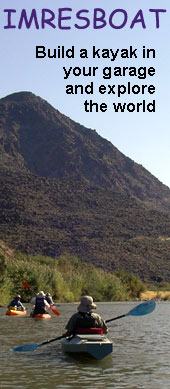Planimeter

Some might DIY with a stick and a blade.
That's from.
Graeme
Stash
I read where you go days in the Texas 200 in small boats. My moto everything has two uses and this goes for insect spray. In one of those moments where one has no flyspray and heaps of insects to contend with, I used spray on olive oil. That's right the stuff you spray on your sauce pan. Works a treat there and as a insect repellent. Why one might ask well the propellant in these and a lot of spray on stuff is butane gas, yes butane, and this product is deadly to insects but I don't know how good it is for human intestines.
Stewart
Angle Grinder
OK, I have finished the replacement of the bottom of my Weekender and I want to impart what I have learned:
An angle grinder with a 40grit sanding disk is the BEST woodworking tool I have found, bar none. BEST. THING. EVAR! I'm like a gorram sculptor with that thing now. Thankee kindly, John Welsford, I do appreciate that bit of advice.
IF you use staples to hold your glass in place while you mix your epoxy, THEN circle the staples with a Sharpie or some such so you remember where it is. Better yet, just tack it in, so it stands proud and you can easily remove it once the cloth is wetted and sticking to the surface.
DON'T SAND BETWEEN COATS OF EPOXY - what an a waste of time, material and money that was. Why why why did I think that was a good thing?
Andrew
John Harland
John Harland's book, Seamanship in the Age of Sail: An Account of the Shiphandling of the Sailing Man-of-War 1600-1860, based on Contemporary Sources, is said to be the best on the subject of how square-riggers were sailed up until the 1860s. Focusing on Navy practice, but much should be applicable to merchant ships. I haven't read the book, but John H hangs out in a maritime history mailing list I belong to, and seems to know his stuff.
In the late 1800s a lot of labor saving improvements were being made to square riggers (except in the Navies, who by then mostly had sails just to give the crews work to do <g). By the end of the age of commercial sail huge ships were being sailed by remarkably small crews, often mostly made up of overworked apprentices! Many of Antipodean Alan Villiers' books give a good taste of sailing in the final days of merchant sail.
en.wikipedia.org/wiki/Alan_Villiers
And Irving Johnson's film of a 1920s passage around Cape Horn in a big
square-rigger is a must-see for anyone interested in sailing ships. (My friend Charley claims that when he was a kid Irving Johnson would stop when he was in town by to drink whisky with his dad.)
John Kohnen
www.boat-links.com/boatlink.html
Adrian Seligan
Other good books are by Adrian Seligan. The Voyage of the Cap Pilar being his most famous (it was an inspiration for Francis Chichester), but "The Slope of the Wind" tells of his trips round Cape Horn in the 1920/30's on square riggers.
And as his obituary shows he had a "interesting" life. I met him in the late 1990's. I never thought I'd met someone who had actually sailed a square rigger round Cape Horn. A fascinating guy to talk to.
Richard Woods
Electric Shock Drowning: What You Need to Know From BoatUS

A diagram of how Electric Shock Drowning occurs.
(Courtesy of David Rifkin. This image available at:BoatUS.com/pressroom/previewimg/hires/esd.jpg)
IN GENERAL:
- Tell others about ESD. Most people have never heard of it and are unaware of the danger.
- To retrieve a person in the water, reach, throw, and row - but don't go.
- Make sure your children understand the importance of not swimming anywhere there could be electricity. Don't let them roughhouse on docks. Tell them what to do if they feel a tingling or shock in the water (see below).
- ESD victims are good candidates for successful Cardiopulmonary Resuscitation (CPR). Learn to perform CPR and maintain your training.
IN MARINAS:
- NEVER swim within 100 yards of any freshwater marina or boatyard.
- Talk to marina owners or operators about the danger of ESD. Ask your marina operator to prohibit swimming at their facility and post signs.
- Ask marina operators if they are aware of and follow the guidelines in National Fire Protection Association (NFPA) 303 (fire protection standard for marinas and boatyards) and National Electric Code (NEC) 555.
IF YOU HAVE A BOAT:
- Have your boat tested once a year to see if it is leaking electricity, or buy a clamp meter and test it yourself. If you find any problems, have your boat inspected by a qualified electrician trained to American Boat and Yacht Council (ABYC) standards.
- Have a qualified ABYC electrician install an Equipment Leakage Circuit Interrupter (ELCI) on your boat (refer them to the ABYC E-11 Standard) or use a Ground Fault Circuit Interrupter (GFCI) in the shore power cord. As an alternative, install an isolation transformer on the boat.
- Test the GFCI/ELCI at least once a month or per the manufacturer's specifications.
- Do NOT do your own 120-volt AC electrical work on a boat or hire an electrician who is not familiar with ABYC standards to do it. Many of the problems that lead to an electrical fault on the boat result from the differences between shore and boat electrical systems and standards.
- DO NOT use common household extension cords for providing shore power to your boat. Use, and encourage other boaters to use, shore power cords built to UL standards, ideally with a GFCI built in.
- NEVER dive on your boat to work on underwater fittings when it is plugged in to shore power, even in saltwater.
IF YOU HAVE A PRIVATE DOCK:
- NEVER swim within 100 yards of ANY dock using electrical power!
- If you have not electrified your dock or put an AC system on your boat, weigh the risks carefully before doing so.
- If you need electricity on your dock, hire a licensed electrician and make sure the wiring meets the requirements in NFPA 303 and NEC 555. If your dock is already wired, hire an electrician to check that it was done properly. Because docks are exposed to the elements, their electrical systems should be inspected at least once a year.
- Exercise your GFCIs/ELCIs as recommended by the manufacturer.
- If you normally run a power cord from your house or garage to charge your batteries, make sure the outlet has a GFCI and include a GFCI somewhere in the shore power cord.
- NEVER swim off your dock without shutting down all shore power to the boat and the dock.
- Even if you adhere to all of these rules, nearby docks can still present a shock hazard. Educate your neighbors and work together with them to make the waterfront safe.
IF YOU'RE IN THE WATER AND YOU FEEL TINGLING OR SHOCKS:
- DO NOT follow your instinct to swim toward the dock!
- SHOUT! When electricity is not involved, drowning victims cannot speak, let alone shout. Tell those around you exactly what you're feeling so they can help you while keeping themselves safe.
- Try to stay upright and back out of the area the way you came, warn any other swimmers in the area of the danger, and then head for shore 100 yards or more from the dock.
- Alert the dock or marina owner and tell them to shut the power off to the dock until they locate the problem and correct it.
- Go to the hospital, explain what happened, and ask to be checked over to be sure there are no adverse health effects.
IF YOU HAVE TO RESCUE AN ESD VICTIM:
- Know how to distinguish drowning from ESD (drowning victims cannot speak and look as if they are trying to climb a ladder; screaming, shouting and tingling, numbness, or pain indicate ESD).
- Fight the instinct to enter the water - many rescuers have died trying to help ESD victims.
- Call for help. Use 911 or VHF Channel 16 as appropriate.
- Turn off the shore power connection at the meter base and/or unplug shore power cords.
- Get the victim out of the water. Remember to reach, throw, row - but don't go.
- If the person is not breathing or you cannot get a pulse, perform CPR until the Fire Department, Coast Guard, or ambulance arrives.
|







